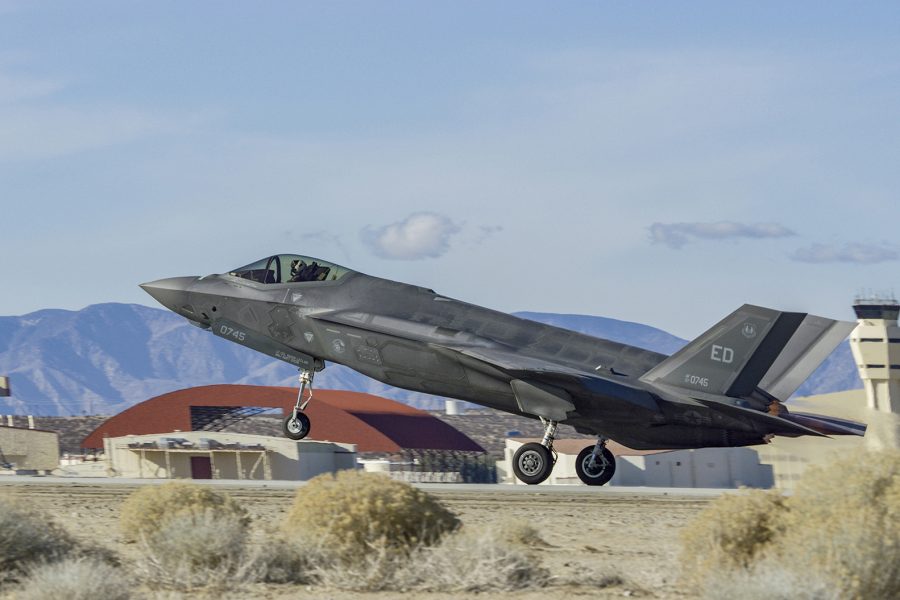Congress added three extra F-35s to the Air Force’s fiscal 2024 buy in the appropriations bill passed and signed this weekend and boosted the fighter’s F135 engine account as well.
The final bill adds $541 million for F-35-related procurement, of which $277 million will buy the three additional A-variant fighters and $264 million will buy “engine spares,” split evenly between Air Force F-35As and the Navy and Marine Corps F-35Bs and Cs. It was not immediately clear whether the engine money would buy full-up spare engines or spare parts, but Congress has shown interest in improving F-35 readiness, which has suffered in the past due to engine and engine parts shortages.
The figures appear in the bill’s joint explanatory statement.
Of note, while the Air Force has included additional F-35s on most of its “Unfunded Priorities Lists” in recent years, it did not include the F-35 on its list for fiscal 2024.
The add would raise the Air Force’s 2024 buy to 51 F-35As, up from the 48 requested in FY24. In the new FY25 budget just presented to Congress this month, the Air Force only asked for 42 F-35s, explaining that it had to make cuts to several portfolios, including fighters, to live within the Fiscal Responsibility Act, which carved $2 billion out of USAF’s spending plan.
Lawmakers have voiced frustration with the Air Force for saying it needs 72 fighters a year to stop a steady decline in the fighter inventory and its average age, yet still continuing to divest older fighters and not replacing them on a one-for-one basis. In the FY25 budget, the Air Force only asked for 66 fighters—12 of which are F-15EXs—and capped the EX program at 98 aircraft, having originally planned to build as many as 188, and most recently, at 104.
In total, the FY24 bill funds a total of 86 F-35s for the armed services, including 16 for the Marine Corps and 19 for the Navy. The Pentagon asked for only 68 F-35s, across all services, in fiscal 2025.
The F-35 Joint Program Office said it is “aware of the additional three F-35As and will bring this new requirement into the Lot 18-19 negotiations” with Lockheed Martin, which have been underway for more than a year.
Program and industry officials expect unit costs of the F-35 to increase in the next lots, due to inflation, higher labor costs, and the fact that the Block 4 aircraft will be a more advanced platform than its predecessors, with more electronic warfare features and capability for more weapons, among some 80 upgrades.
Asked for comment, a Lockheed spokesperson said that increased quantities are among “the main drivers to keep the F-35 affordable and are key to ensuring economies of scale and affordability across the life cycle of the program.”
The Air Force’s high water mark of F-35s bought in a single year was 60 in fiscal 2021. Since then, it has asked for fewer, explaining that it prefers to buy more future jets with the Block 4 configuration rather than have to later retrofit pre-Block 4 models to that standard. Under original program plans, the Air Force expected to be buying 110 F-35s per year by 2025. The service has never changed its total objective of 1,763 F-35s, set 25 years ago. At its current pace, it will not achieve that inventory until the 2040s.
Lockheed Martin has produced—but not delivered—dozens of F-35s since last fall, because they are configured with the Tech Refresh 3 suite of processors and software that is still being proven in flight tests. The TR-3 is the processing and software foundation of the Block 4. Lockheed is storing some 70 F-35s at an undisclosed location until the hold on deliveries is lifted, which industry and government officials expect to happen in late summer.
The JPO said it is “exploring the possibility of truncating the TR-3 with our industry partners, the U.S. services, and International Partners to ensure warfighters have the aircraft and capability needed,” but has not predicted when that decision might come. Pentagon officials have said they may be open to permitting deliveries to resume because the jets are needed to maintain the pace of delivery and absorption and to match pilot training requirements. Deliveries might resume first to international partners, one official suggested.
